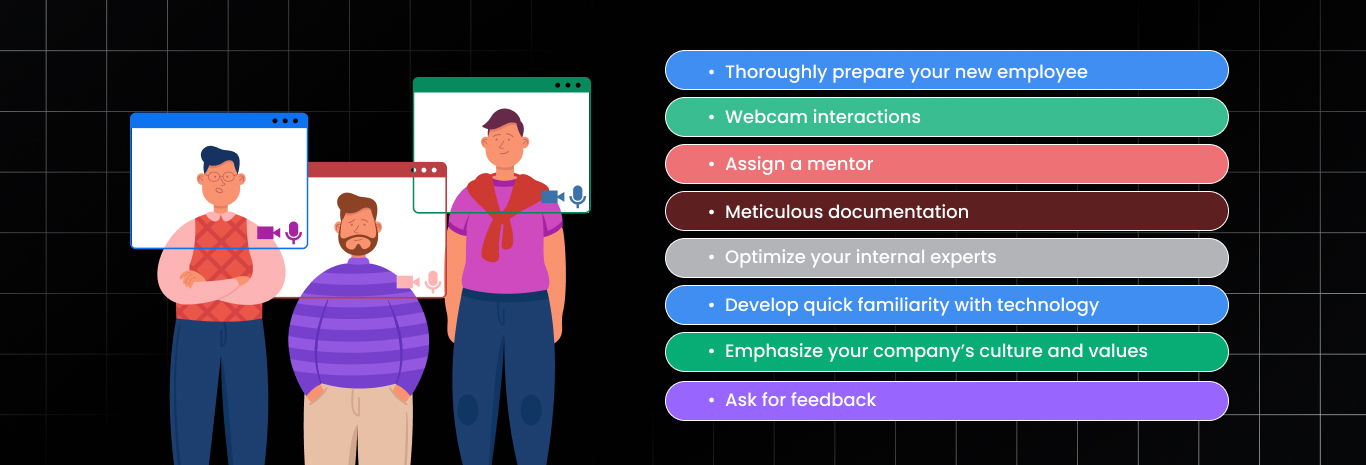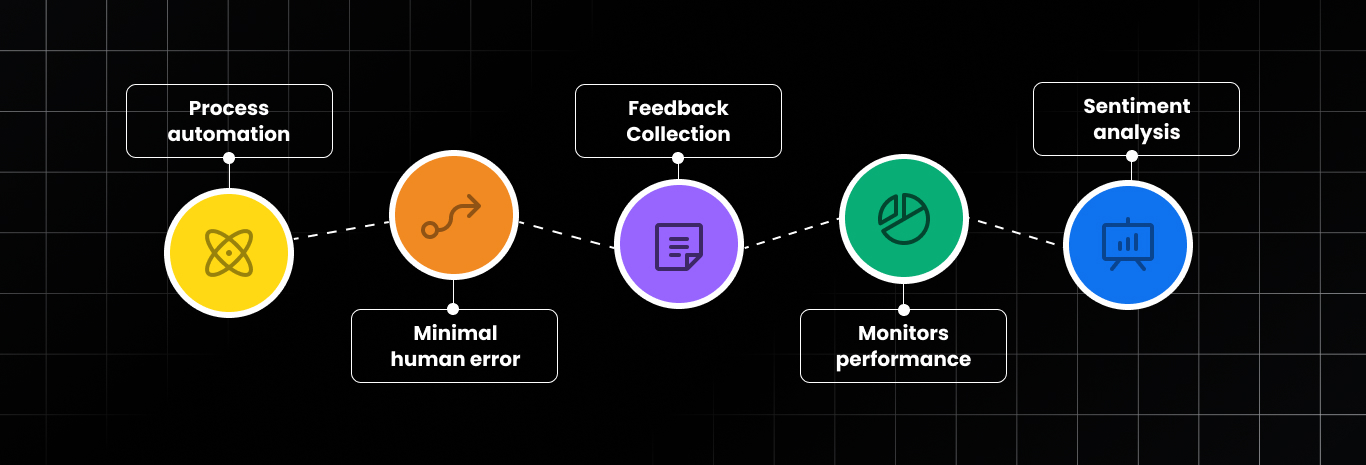Over the last few years, many companies have started focusing on delivering a great onboarding experience. As per surveys, investing in onboarding systems for a hassle-free process will drive increased employee engagement, better productivity, and a reduced turnover rate. But in the wake of the pandemic, onboarding has changed forever as workplaces adopt remote or hybrid work models. Virtual onboarding has become the norm in today’s landscape.
In today’s article, we’ll discuss virtual onboarding and how to implement a smooth onboarding process in a hybrid work model.
What is virtual onboarding?
Virtual onboarding is the process of onboarding new hires virtually. The process involves familiarizing the recruits with the company’s work culture and conducting all the documentation required to get them started on the role they are hired for.
Core aspects of the virtual onboarding process

Virtual onboarding programs take over several aspects of the hiring process, such as documentation, mentors, and initial training. Here are the three critical pillars for ensuring your virtual onboarding is successful.
- Organizational: This involves familiarizing the employee with the company’s mission, vision, goals, logistics, and internal work culture. It gives the new hire a clear picture of their job role and helps them navigate their day-to-day work schedule easily. A smooth virtual onboarding of employees knows which department or personnel to approach regarding different issues.
- Technical: Integrating AI is now critical in virtual employee onboarding. It helps new hires by leveraging automation to simplify setting up their log-in credentials, assigning company IDs, parking spaces, and access to the company’s internal communication channel and resources.
- Social: For a smooth and stressless onboarding, you must help your new hires network with their colleagues and teammates. The virtual onboarding process creates a platform where existing employees and new hires can easily communicate with each other and grasp a more comprehensive picture of their new workplace or job role.
How is virtual onboarding different from traditional methods?
The traditional onboarding process requires the presence of both the HR and candidate onsite whereas virtual employee onboarding capitalizes on technology as a medium to introduce, acquaint, and socialize new hires. From documentation to orientation, a new hire goes through numerous steps conducted by the company’s HR department. Traditional onboarding typically involves:
- An onboarding presentation
- Office tour
- Discussion with HR about the job role
- Q&A with the respective team leaders
- Physical paperwork
Traditional onboarding takes up a significant amount of time and is prone to human errors. The virtual onboarding process, on the other hand, does not require the new hire to be present in the office to complete onboarding. It omits the need for lengthy paperwork or repetitive welcome presentations.
A recent report by UrbanBound stated that automated onboarding resulted in 16% better retention rates for new hires and 18% improved achievement in their initial performance.
With the help of technology, virtual onboarding saves time and takes care of all the repetitive tasks. This way, the new hires become acquainted with their job roles quickly, get access to their credentials, and maintain interaction with their colleagues and teammates from the comfort of their homes. This significantly improves employee experience.
Why do your virtual onboarding processes matter?

Whether you have a hybrid or remote work mode, virtual onboarding can work wonders for your employee engagement strategy. Investing more in communication and engagement during the preboarding process can improve the overall onboarding experience.
Here’s why you should adopt virtual onboarding for your organization:
Saves time
There are multiple processes involved in onboarding – setting up log-in credentials, signing multiple forms, and recording employee information in the system. A tedious experience on the first day reduces employee satisfaction. Virtual onboarding makes it easier and hassle-free. Going digital with onboarding will spare the new hires from getting overwhelmed, allowing them to focus on understanding their responsibilities.
24X7 accessible resources
The problem with physical onboarding is that employees don’t have a comprehensive record of resources and must find their way through many hoops to find the answers. But with virtual onboarding, PDFs, video content, infographics, and other solutions to general queries are integrated into the system. These can be accessed by an employee remotely, allowing them to quickly check their orientation material online whenever needed.
More accuracy
Physical onboarding requires a lot of manual intervention. This makes the process highly prone to errors. Virtual onboarding has more accurate results. The AI-powered system seamlessly integrates information and passes details without any error.
Easy networking
In-person communication with colleagues has become nearly impossible with remote working modes. But virtual onboarding gives the existing employees and the new hires a mode to communicate even before the first day. The fresh employees can ask questions to the experienced ones and form a bond from any corner of the world. This facilitates better teamwork and healthy work culture in remote work models.
Improved retention rate
According to O.C. Tanner, 69% of employees who get a smooth onboarding are likely to continue for more than three years. When you don’t overwhelm your employees with bulks of paperwork and complicated sets of onboarding processes, they develop a good image of you as an employer. A smooth onboarding experience can positively increase your employee retention rate.
What are the focus areas for creating a tremendous virtual onboarding experience?

While the onboarding process may look different for every organization, here are a few focus areas you should not miss:
Thoroughly prepare your new employee
One of the tricky parts of virtual onboarding processes is that it’s much easier to miss details during orientation. Creating detailed guides and resources will make your employee’s learning curve much smoother.
Webcam interactions
Allow your new hires to interact with the team members face-to-face early in the onboarding process. This will help them become familiar with their team quickly. Keep some starter questions and topics ready to help break the ice. Schedule virtual meetings with crucial company figures as well.
Assign a mentor
Assigning mentors to each new hire will make them feel comfortable asking questions. Assigning off-hour mentors will be especially beneficial if you have new employees working from different time zones.
Meticulous documentation
Make sure your new hires have received all their necessary documentation as an employee of your organization. Never rely on ‘your head knowledge and provide them with job-specific processes and procedures for virtual onboarding activities.
- Optimize your internal experts
Give your organization’s existing talent a chance to pass on their learnings, skills, and experience to the new hires. Your virtual onboarding process should accommodate such sessions consistently.
- Develop quick familiarity with technology
Provide them with the necessary technology as soon as possible. Earlier, employees collected the company-provided laptop on site. But with virtual onboarding, they ship their working system quickly. Ensure they can access the necessary credentials and software as soon as they open the laptop.
Emphasize your company’s culture and values
Your virtual onboarding process should reflect your company’s goals, expectations, and work culture. A healthy work culture impresses new hires and motivates them to work with your company.
Ask for feedback
Virtual onboarding is a reasonably new addition to the workplace, but there is still much room for improvement. Your new hires are the best people to tell you the areas that need upgrades. In such cases, surveys can provide you with actionable insights. After onboarding, ask your new employees to give feedback on their onboarding experience. This will also make them feel valued and ultimately add to the employee experience.
Creating an excellent virtual onboarding experience requires looking into many aspects; that’s precisely why leveraging technologies such as artificial intelligence comes into play.
How do artificial intelligence tools help in creating a great employee onboarding experience?

Artificial intelligence has several benefits when it comes to onboarding:
Process automation
AI-integrated virtual onboarding processes can automate repetitive processes that otherwise take a lot of time.
Minimal human error
Without the chances of human error, the onboarding process becomes much more organized with the integration of artificial intelligence. All the information is automatically recorded in the system and can be accessed anytime. Such organized employee records and a systematic onboarding process make it easier for both HR and new hires.
Feedback Collection
After the completion of onboarding, AI-integrated systems automatically send feedback questionnaires to the new hires. This saves time and is much more efficient than manual feedback collection.
Monitors performance
AI-enabled onboarding systems can track a new hire’s performance and progress in real-time and provide detailed and accurate reports.
Sentiment analysis
AI-enabled onboarding systems can go beyond and analyze the behavioral patterns and sentiments of new employees. This helps the company to build personalized employee experiences, resulting in a lesser number of drop-offs.
Checklist for great onboarding experiences
Preboarding
- Plan a clear start and end point for the onboarding process.
- Schedule equipment and swag delivery and set-up
- Familiarize your existing employees with the technology to enable them to help the new employees.
- Structure and send the welcome email with Day 1 agenda
- Provide a contact number in case they have any doubts
- Prepare a plan for the 1st and 2nd week
Onboarding
- IT set-up should be the first point in the Day 1 schedule
- Send separate meeting links- one with the team and one with the leadership
- After IT onboarding, a 1:1 virtual meeting with the manager should be next
- Day 1 schedule includes a brief overview of the team and job responsibilities
- Virtual meeting with the team
- Inform them about the team’s previous projects
- Keep some interesting topics handy to keep the flow going
- To make onboarding more interesting, add some fun activities to the schedule
- Provide technology overview
- For a smoother process, deliver the right content in the correct sequence
Post-onboarding
- Make sure the new hires have a clear idea of their job roles
- Share the onboarding feedback questionnaire with every new employee
FAQs:
What are the advantages of virtual employee onboarding?
Virtual employee onboarding saves time, is more accurate, and makes the experience hassle-free for both the HR department and the employees. Thus, automated onboarding can significantly improve the employee experience.
What are the disadvantages of virtual onboarding?
As it is a relatively new addition to workplaces, the employees might need time to fully adjust to the virtual onboarding process. It also lacks the face-to-face interaction that new hires could enjoy in a traditional onboarding setup.
How can HRs tackle the disadvantages of virtual onboarding?
By incorporating an efficient AI system, HR departments can overcome the disadvantages of virtual onboarding. HRs should enable frequent check-ins and common networking platforms to personalize the onboarding process. Keeping an open mind to employee feedback is also a great way to improve the virtual onboarding strategy.
Final thoughts
With the new norms in place, virtual onboarding is the future for the global workforce. According to a survey by Upwork, 73% of employees in all departments will include remote workers by 2028.






